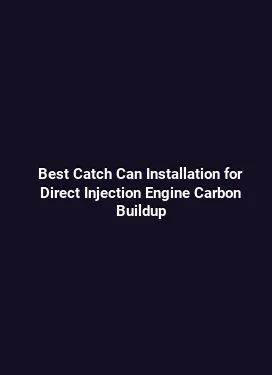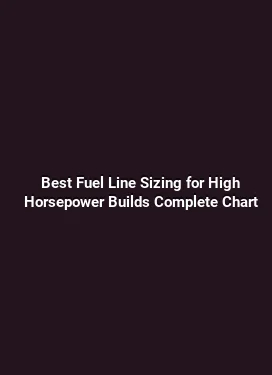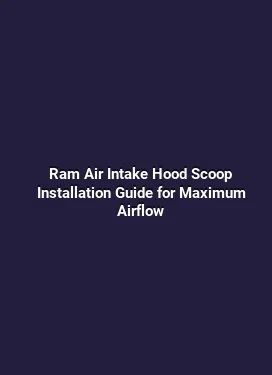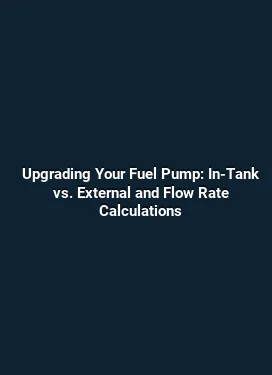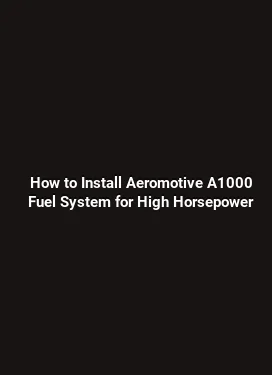Understanding Fuel Injector Sizing: A Formula for Matching Flow to Horsepower Goals
In modern performance tuning, the intake and fuel system form a critical bridge between air mass entering the engine and the fuel that combusts to create power. Fuel injectors are the precise control elements that deliver fuel in step with each cylinder’s demand. Getting injector sizing right is not just about reaching peak horsepower; it’s about achieving consistent throttle response, reliable idle, and safe operation across RPM ranges. This article delves into the practical framework for choosing injector flow based on horsepower aspirations, engine displacement, efficiency targets, and supporting system components. The discussion moves beyond theory to actionable calculations, real-world constraints, and tuning considerations that show up on the dyno and in street-driven cars alike.
Why Injector Sizing Matters in Modern Intake & Fuel Systems

Fuel injectors are the gatekeepers of metered fuel. Their flow capacity, spray pattern, atomization quality, and response time determine how closely the engine can translate air charge into controlled combustion. Under-sizing injectors can cause lean conditions at high load, leading to detonation risk and misfires, while oversized injectors can complicate idle quality and fuel trims. The goal is to align injector flow with the engine’s peak fuel demand during heavy accelerating, sustained boost, or high-rev operation, while maintaining a comfortable margin at idle and part-throttle operation.
In boosted or high-compression builds, the demand profile shifts. A turbocharged four-cylinder in the 2.0–2.5 liter range may require substantially more fuel during spool and peak boost events compared to a naturally aspirated variant of similar displacement. On the intake side, plenum design, runner length, throttle body size, and intake tract tuning influence air mass flow, which in turn sets the fuel requirement. Fuel system components—pump, lines, regulators, rails—must be matched to ensure consistent rail pressure and spray behavior as duty cycle changes. The result is a harmonized intake and fuel system where air and fuel rise and fall together in a predictable pattern.
From a practical standpoint, injector sizing affects three core performance axes: maximum horsepower capability, driveability at part throttle, and hardware reliability under sustained load. The sizing decision is rarely a single-number calculation; it’s a synthesis of displacement, volumetric efficiency, boost targets, fuel type, and the engine’s breathing efficiency. Real-world tuning demands a transparent method to estimate fuel demand across the RPM spectrum and adjust for fuel pressure and injector spray characteristics that influence overall fuel delivery accuracy.
Core Formula: Mapping Flow to Horsepower
A widely used starting point for injector sizing relates the injector flow rate to the engine’s horsepower goals and volumetric efficiency. A practical, iterative approach combines the engine’s displacement, desired horsepower, VE (volumetric efficiency) estimates, and a safety margin. The core idea is to compute the required fuel mass per hour and then translate that into an injector flow rate that can deliver it with an appropriate duty cycle at expected rail pressure.
The approximate formula uses the following relationships in a simplified form:
Required fuel flow (lb/hour) ≈ (Engine horsepower × Brake Specific Fuel Consumption × 1.1) / (Volumetric Efficiency × 0.262)
Where the Brake Specific Fuel Consumption (BSFC) is an engine-specific value typically ranging from 0.38 to 0.50 lb/(hp·hr) for many modern engines under boost or performance tuning, and the factor 0.262 converts pounds to gallons for a typical gasoline energy basis in US units. The 1.1 multiplier provides a cushion for transient and boost-rich conditions. Volumetric efficiency is a parameter that captures how effectively the engine fills cylinders at a given RPM and load; it varies with RPM, cam profile, intake tract design, and boost strategy. In practice, VE is often estimated from baselines or dyno data, and then refined during tuning sessions.
Once the fuel flow requirement is established, injector size is selected to achieve that flow at a practical duty cycle. Duty cycle denotes the fraction of time the injector is open during each engine cycle. A common target range for many engines is 70–85% maximum duty cycle at peak power, with idle and part-throttle operation kept within comfortable limits (often under 60–65% at cruising conditions, depending on the injector and engine management system). If the calculated required flow implies a duty cycle that is too high (or too low) at the expected rail pressure, a larger (or smaller) injector is chosen accordingly.
Rail pressure and spray pattern influence the effective flow versus labeled flow. Many modern injectors are rated at a standard pressure (for example, 3 bar or 43 psi for older systems, 3.5–5 bar for newer setups). Increases in rail pressure can substantially raise the effective flow, but this also changes spray cone behavior and atomization. Therefore, the sizing exercise must account for the actual supply pressure the engine will see during operation, not just the injector’s nominal rating. In boosted engines with electronic pressure regulators, the relationship between rail pressure and flow is approximately linear within the operating range, but it remains essential to validate with real-world measurements and datalogging during tuning sessions.
Practical Example: Naturally Aspirated V6

Consider a 3.0-liter naturally aspirated V6 with a goal of 420 horsepower at the crank and a rough VE estimate of 0.85 in the mid-range. Using BSFC around 0.42 and applying a 1.1 margin, the fuel flow required is roughly:
Fuel flow ≈ (420 × 0.42 × 1.1) / (0.85 × 0.262) ≈ 219 lb/hour
Selling the page: selecting injectors rated near 240–260 lb/hour nominal flow at the system rail pressure would provide adequate headroom, keeping expected duty cycles comfortable across RPM bands. After accounting for potential injector performance variations, a chosen pair of high-quality units with a total flow in the 480–520 lb/hour range could be appropriate for a 6-cylinder engine, factoring in a modest margin for surge and smoke-free idle. The next tuning step would be to set baseline fuel trims, verify rail pressure stability, and confirm spray patterns on a flow bench or via dyno data with precise lambda measurements.
Interplay Between Intake Design and Injector Performance
The intake system defines how air mass responds to throttle input and RPM. Plenum volume, runner length, and port sizing influence the engine’s air charging efficiency and pressure oscillations. A well-matched intake can reduce pumping losses and improve VE, which in turn lowers the required injector flow for a given horsepower target. Conversely, a restrictive intake can force higher injector duty cycles to achieve the same output, pushing injectors toward their limits and increasing heat and wear on the fuel system.
In boosted applications, intake design becomes even more critical. Turbochargers increase the air pressure delivered to the cylinders, but the breathability of the intake tract and the response time of the throttle body determine how cleanly the compressor maps onto the engine. A smooth, well-tuned intake path helps maintain stable manifold pressures and reduces the likelihood of fuel instability at the point of boost onset. When injector sizing is combined with a robust intake strategy, drivers experience cleaner transitions, reduced ignition knock risk, and more predictable horsepower gains as boost is dialed in.
Another practical consideration is fuel pressure management. Upgrading to higher-flow injectors often necessitates supporting changes to fuel pumps, lines, and regulators to prevent pressure drop under high-demand events. Maintaining a stable rail pressure ensures the injector’s advertised flow remains accurate across the RPM range. For drivers who push into high-boost territory, it may be necessary to install a pressure relief strategy or to re-tune the engine management map to accommodate altered spray characteristics at elevated pressures.
Understanding Spray Characteristics and Atomization
The physical design of the injector nozzle governs spray pattern, spray angle, and droplet size. A well-atomized fuel spray improves mixing efficiency with the incoming air, promoting more complete combustion and reducing emissions. Inadequate spray quality can cause stratification and misfires, particularly under transient loads. When selecting injectors, it is important to review spray type (sector, multi-hole, or pintle), spray angle, and compatibility with the fuel delivery system. For engines with tight combustion chambers or high compression, precise spray control becomes even more critical to achieve stable idle and robust mid-range power without leaning out under boost.
Coupling injector choice with ECU capability is essential. Modern engine management systems can implement fine-grained fuel trims, alpha-N or speed-density mappings, and advanced dithering strategies to smooth out injector timing and flow variability. A capable ECU enables more aggressive performance goals while maintaining reliability, as it can compensate for minor discrepancies in injector performance across different operating temperatures and fuel grades.
Fuel Type, Ethanol Blends, and Real-World Tuning Impacts
Fuel composition affects injector performance and the required flow. Ethanol blends, for example, have a higher latent heat of vaporization and typically require more fuel per unit of air to achieve the same stoichiometric ratio. Engines running on higher ethanol content often benefit from larger injector flow or higher fuel pressures to sustain rich-enough mixtures at full power. Conversely, gasoline-only setups can operate with slightly leaner trims if the cooling effect of ethanol is not present. Tuning for ethanol blends should consider air-fuel targets, corrected BSFC, and the safety margins in the injector duty cycle to avoid running too close to the limit during peak boost and hot weather operation.
Another practical factor is ambient temperature and fuel demand during variations in climate. Cold starts, hot days, or long highway cruises can subtly shift air-fuel balance. A well-calibrated injector system includes flexible duty-cycle ranges and robust fuel trims that adapt to these conditions without compromising performance or reliability. In addition, using modern diagnostic tools to monitor lambda, rail pressure, and injector pulse width in real time helps technicians adjust injector sizing decisions after initial dyno sessions and road testing.
Case Study: Boosted 2.5-Liter I-4 with Upgraded Injectors
Imagine a 2.5-liter turbocharged inline-four targeting 360 horsepower at the crank. With a VE estimate of about 0.85 in boost and a targeted 0.42 BSFC under load, the initial fuel flow calculation yields a requirement around:
Fuel flow ≈ (360 × 0.42 × 1.1) / (0.85 × 0.262) ≈ 190 lb/hour
Choosing injectors in the 210–240 lb/hour nominal range, with rail pressure calibrated to maintain stable flow, offers a generous margin for transient events. After installation, a dyno run under full boost confirms the injector duty cycle remains within a safe window and lambda stays within desired limits. If readings indicate a tendency toward lean misfire at redline, the next steps may include increasing rail pressure, adjusting the fuel map, or slightly increasing injector size to accommodate the peak flow demands without compromising idling and part-throttle stability.
Best Practices for Validation and Safety
Validation is a multi-step process that begins with a thorough calculation, followed by bench testing, and concludes with real-world validation on a dyno and street driving. Key steps include verifying rail pressure stability across RPM, confirming the injector’s actual flow at the target pressure via flow bench data or precise measurement, and logging AFR trends under varied load conditions. Safety margins should be baked into the design so that small environmental changes, fuel grade differences, or minor hardware tolerances do not push the engine into unsafe operation during aggressive tuning.
It is essential to document baseline conditions before upgrades, including stock injector flow, rail pressure, and VE estimates. After upgrades, repeated measurements of fuel pressure at idle, part throttle, and wide-open throttle provide a clear picture of whether injector sizing remains appropriate across the entire operating envelope. If significant deviations occur, revisit the VE assumptions, verify input data in the tuning software, and consider a re-evaluation of the injector choice and supporting hardware, such as pump capacity and regulator type.
Finally, the integration of an efficient intake system with accurately sized injectors yields a high-performance combination that is not only powerful but also predictable. Consistent air-fuel delivery across RPM bands translates into smoother throttle response, more linear torque delivery, and a better driving experience on both the street and the track. A well-tuned intake and fuel system harmonize to deliver reliable power gains while keeping emissions and fuel economy within realistic expectations for the build.
Closing Notes on Practical Tuning and Consistency
In summary, injector sizing is a balancing act that considers horsepower goals, engine displacement, VE, fuel type, and supporting hardware. The goal is to achieve a safe, repeatable, and responsive power curve without resorting to overly aggressive duty cycles that shorten injector life or destabilize idle. By combining a rational sizing method with careful validation, tuners can realize meaningful performance improvements while preserving long-term reliability. The practical approach relies on precise calculations, thoughtful selection of components, and iterative testing to confirm that the intake and fuel systems work in concert to deliver the desired horsepower with consistent behavior across RPM and temperature variations.

